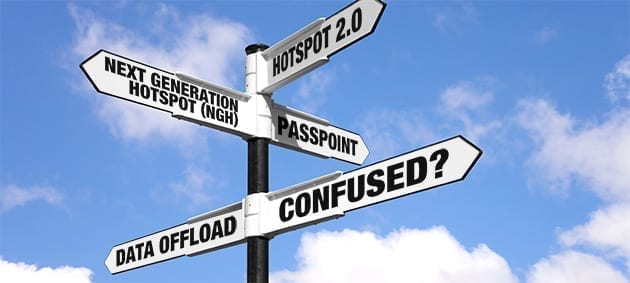So what is Hotspot 2.0, how does it relate to Passpoint and Next Generation Hotspot (NGH) and – what’s all the fuss about?
Confused? You’d be forgiven if you were and would be in good company.
Firstly, I will explain how they are related. Hotspot 2.0 is an initiative driven by the Wi-Fi Alliance and is broadly based on the 802.11u standard. Passpoint is the certification from the Wi-Fi Alliance that says a piece of equipment works with Hotspot 2.0. Next Generation Hotspot takes the process beyond the equipment – covering authentication back to Operators, Service Providers and Carriers.
Ultimately, to the end user it means a better experience, whatever we call the intermingled elements of Hotspot2.0 and NGH.
I believe that there is good reason for all the fuss about these topics which will really change the public wifi landscape and experience. And it’s going to create a whole new market around data offload and onload.
If we take the current experience of your average Joe looking to use public wifi. First he opens his settings, opens his wifi and looks for available networks. And depending on where he is – there could be an awful lot to choose from. He looks for ones without the lock symbol and wonders what’s on the other side?
If he had more answers at this stage, it would really help him choose whether to connect:
- Is there a deal with my mobile operator?
- Am I going to have to pay?
- Do I need to register?
- Is it over-congested?
- Is the internet even working – will I get online?
- What sort of speed can I expect?
Once he finally takes the plunge and connects, he’ll most likely have to open a browser, browse to a non secure site at which point he will arrive at the splash/landing page. If he’s lucky enough to be at a Social Wi-Fi Hotspot then registering will be simple. If not, then he had best get ready for the form and maybe even get out a credit card. And finally he’s online. Simple?
It’s amazing how many people wouldn’t be able to get through that and different people will give up at different points. What’s even more frustrating and confusing is that on your next visit, if the hotspot provider doesn’t have seamless login to wifi, it will still look like you are connected. You will assume you are connected to wifi because the symbol is there on your device, but the reality is that you will probably have to log in again. Seamless!
That’s all going to change with Hotspot 2.0/NGH. Using something called realms and EAP Authentication you could very well walk into a public wifi area, not even take your device out of your pocket or bag and in the background decisions are being made about which is the best network to join. Your device will even be evaluating whether it is worth doing so based on speeds of WiFi vs 3/4G and how congested each one is.
This is all assuming there is some sort of roaming agreement in place. This could be between your mobile operator, the hardware manufacturer, the broadband provider or someone else. And this is an area that will get very interesting in the next few years.
If a roaming agreement isn’t in place, people will still be able to view the available networks, with more detail about them, so they can make a more informed decision before connecting. The process will be so much smoother with no need to open browsers and enter URLs.
The three drivers for seeing this really take hold are:
1) The wifi equipment being able to support the technology (which is in full swing)
2) The devices being able to support it (this has been given a massive boost with support in iOS7.)
3) The final piece of the jigsaw is in software (like ours) bringing all of this together.
The future is bright, more connected and, hopefully for those of us in the industry, just around the corner.
